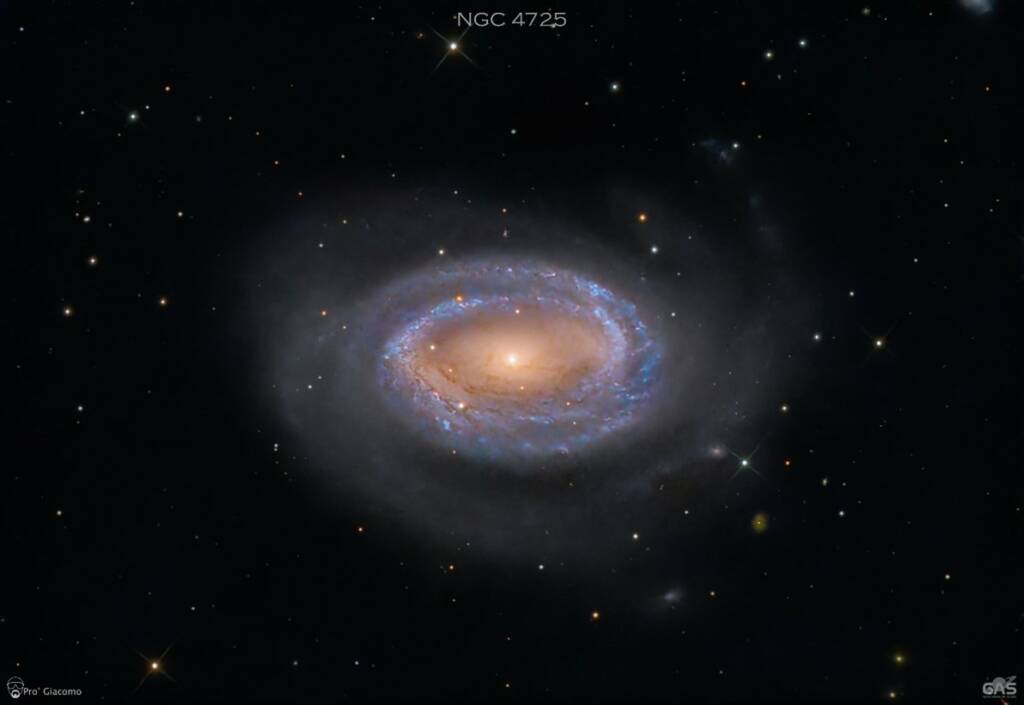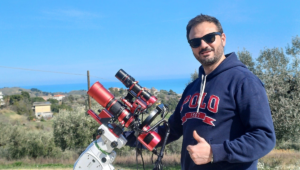
Astrophotographer’s Story: John Park
Hello John, thanks for accepting our interview invitation. Congratulations on winning the ASIWEEK competition in week #25/2024! Q1: At first, congratulation that your nice image won #ASIWEEK. Can you introduce

Hello Giacomo, thanks for accepting our interview invitation. Congratulations on winning the ASIWEEK competition in week #34/2024!

Thank you very much. I am very happy that my photo of the galaxy NGC 3718 was voted as
the ASIWEEK photo of the week. My name is Giacomo Pro’, I’m 48 years old. I work for the Italian Ministry of Defense and live in Torricella, a small town in Southern Italy.

Since I was a child I have always had a great interest in astronomy. The passion for astrophotography ignited in the summer of 2020 with the passage of the comet C/2020 F3 (NEOWISE). It was that event that pushed me to try to photograph the night sky and its wonders. I started from scratch with a reflex camera and a tripod, I immersed myself in articles, tutorials and manuals, studying and trying, making mistakes and starting again. As my passion grew, I began to purchase increasingly suitable and sophisticated equipment. This led me to gain experience and consequently to obtain increasingly satisfying results.

For me, the most fascinating thing about astrophotography is capturing objects that are very far away from us and are difficult to see with visual equipment.


The peculiarity of this subject, beyond its cosmic beauty, is that it was taken with a ZWO ASI 224 planetary camera. I have also done other deep sky work with this camera, taking advantage of the fast F4 focal ratio of the telescope and above all the high sensitivity of the sensor with exposures contained within 60″ to avoid thermal noise, which is however contained and manageable even if it is not a cooled camera.

Planetary Camera: Asi 224 mc color – Asi 120 mini
Camera: Asi 294 mc pro
Telescope: Sky-Watcher Quattro 200P – Sharpstar 94 EDPH – Samyang 135
Guide scope: 60 – 320 mm
Mount: Skywatcher Eq 6-r Pro – Ioptron sky guider pro
Acquisition: Asiair Plus
Software: DSS – Pixinsight – Photoshop

I am a traveling amateur astronomer and with the association I belong to we have several locations where we hold our star parties, but often due to family commitments I also take pictures from the roof of my house (average SQM 19.75). The ASIWEEK-winning galaxy NGC 3718 was actually taken from the roof of my house.


Light pollution is a widespread problem but little addressed by institutions and we amateur astronomers, who always have our eyes turned to the sky, are the ones who have noticed it for a long time and suffer from it the most. Being an itinerant astrophotographer I am always looking for the best sky and sometimes, when possible, unfortunately I have to travel several kilometers to get away from inhabited centers, sometimes even hundreds of kilometers, perhaps to reach fairly isolated or mountainous areas where light pollution is much less present and the sky is much darker. The use of suitable filters certainly reduces its effects, but a good quality of the sky always helps to obtain excellent astrophotography work. Apart from some areas of our planet, the situation has gotten much worse over the years and I hope that one day the Governments will be able to find a common solution to at least prevent the situation from getting worse.


An important step that had a very positive impact on my astrophotographic work was to join the boys and girls of the Gruppo Astrofili del Salento Team. The team is very active in the astrophotographic, observational and above all informative field, in addition, they are part of the team very good and experienced amateur astronomers who share a passion for the beauties of the universe. I always advise all those who want to approach this wonderful hobby to contact a team or association of amateur astronomers in their area. Having people with experience helps to overcome any type of problem that may arise during a photographic or observing session, and receiving the right advice on equipment and various purchases saves money and time. Being part of a group is also important after having acquired our lights, when you get to the PC to process our photos, also in this case the advice of a more expert person will certainly make the result better and more satisfying to the full advantage for your own experience.
Facebook link: G.A.S. Gruppo Astrofili del Salento | Facebook

In recent years the astrophotography world has followed the development of various technologies with more performing equipment and increasingly sensitive and efficient astronomical cameras. You can choose from a wide range of products suitable for every level of experience that satisfies both the most demanding astrophotographers and those looking for something cheaper but that always returns a satisfactory result.

Astrophotography requires a lot of patience. It can happen, even often, to have problems of all kinds when you are under the night sky. It is important to try to study and keep up to date, now there are several online platforms where it is easy to find information of all kinds and categories. In addition, it is important to surround yourself with people with the same passion and perhaps with a little more experience to ask for help. Being part of an amateur astronomer association greatly facilitates problem solving.




I have an Asi 120 mini that I use mainly as a guide camera on all my setups. Then an Asi 224 that I use for some particular deep sky work. As a main shooting camera on all setups I use an Asi 294 mc pro. All my setups are managed by Asiair Plus

We are leaving the galaxy season and approaching the summer sky. My astrophotography projects follow the seasons and the related constellations. I choose the objects that I can follow as long as possible during the night, trying to take as much care as possible in the acquisition first and the data processing afterwards, trying to make the most of my equipment to try to obtain the best possible result.

Hello John, thanks for accepting our interview invitation. Congratulations on winning the ASIWEEK competition in week #25/2024! Q1: At first, congratulation that your nice image won #ASIWEEK. Can you introduce

Things you need to know about photographing the Solar Eclipse. A total solar eclipse is a spectacular and mysterious astronomical event in nature, not only sparking curiosity about the universe

The total solar eclipse in April 2024 is just around the corner. According to NASA, the next visible total solar eclipse to cross over the U.S. after April will come

Hello Jan, thanks for accepting our interview invitation. Congratulations on winning the ASIWEEK competition in week #23/2024! Q1: At first, congratulation that your nice image won #ASIWEEK. Can you introduce

Hello Simone, thanks for accepting our interview invitation. Congratulations on winning the ASIWEEK competition in week #19/2024! Q1: At first, congratulation that your nice image won #ASIWEEK. Can you introduce